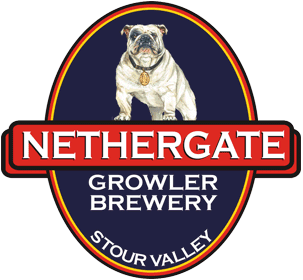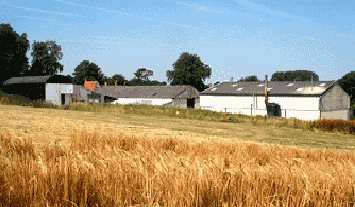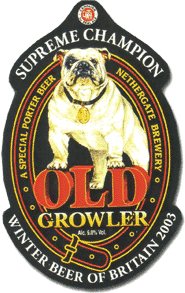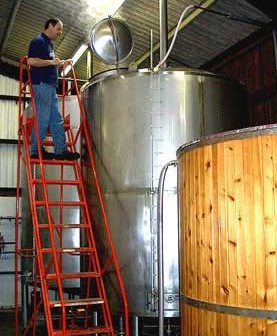 |
 |
|

|
|

|
 |
home
about
features
A-Z
books
|
|
Protz:
features
reviews
tastings
news & events
books
|

| |
Down in Nethergate drive
by Willard Clarke, 05/07
The dread name of Watneys can still strike fear and loathing into an older generation of beer lovers. The giant London brewer wreaked havoc in the late 1960s and 70s with keg beers, Watneys Red in particular, a concoction so awful it tasted like liquid Mars Bars.
The Watney legacy has not completely gone away. When I arrived at the Nethergate Brewery on the Essex-Suffolk border, founder and chairman Dick Burge introduced me to a new member of the team, Andy Bone, managing director.
Andy is a forthright fellow. "My full name," he said, with a piercing look that went straight through to my shoulder blades, "is Anthony Charles Watney Bone."
|
|

|
I sat down, feeling a trifle faint. I have known and admired Nethergate for years. I have watched it grow from small beginnings in Clare, build a fine reputation for such idiosyncratic ales as Old Growler and Umbel Ale, and move
to bigger premises just down the road in Pentlow (below).

|
|
And had all this success come to nought, only to fall prey to Watneys, a company that is to beer what Ghengis Khan was to land reclamation? Andy did his best to reassure me:
Farming and agriculture are his background and he brings to Nethergate a useful knowledge of the barley market. A rise in the price of beer's crucial raw material can have a dramatic impact on a small brewery's profitability.
|
Andy's arrival gives Dick Burge more time to build sales and also look after his wine business, which funded the launch of Nethergate back in 1986. With head brewer Tom Knox and sales director Roger Clark, Dick is busily revamping Nethergate to face the challenges of the 21st century.
Nethergate's reputation is built on its cask ales. As well as mild, the flagship Suffolk County Best Bitter and the pale, complex and fruity Augustinian Ale, the brewery produces the remarkable Old Growler and its even more amazing spin-offs, Umbel Ale and Umbel Magna.
In its early days and under the aegis of its first head brewer, the immensely experienced Ian Hornsey, Nethergate launched Old Growler (5%), based on a mid-18th century London recipe for strong mild. Hornsey re-branded it as porter and, noting that the original recipe had used coriander, fashioned two versions of the beer, Umbel Ale (3.8%) and Umbel Magna (5%), using ground coriander seeds.
Linked to such distributors as Beer Seller and East-West Ales, Nethergate sells its cask beers far and wide. It also does reciprocal deals with other breweries, which is why the beers from Suffolk can be found in North-east England and the Scottish Borders. East-West supplies some Wetherspoon's pubs.
But the beer market is changing at a fast pace. The take-home sector now accounts for around 40% of sales and is expected to rise to 50%. Using his knowledge of the wine business, Dick Burge has embarked on an ambitious programme to make all his cask beers, including seasonal brews, available in bottle-conditioned form as well.
|
|

|
In the brewery, Tom Knox is busily fashioning new beers for both cask and bottle. Essex Border is still in the design stage and may have a rating of either 4.7 or 4.8%. It uses the new English hop, Boadicea - a fitting choice for an East Anglian brewery. Boadicea is bred with low levels of pesticides and is one step away from being fully organic. The beer is pale, hoppy and spicy and will have around 40 bitterness units.
Stour Valley Strong is another new beer that reflects its place of origin. Tom handed me a glass of this stunning brew that he describes as an "entire". This was the first name for porter in the 18th century. Its name came from the fact that it was served entirely from one cask instead of being a blend of pale, brown and old ales from different containers.
Tom's astonishingly complex beer is made from pale, amber, chocolate and crystal malts with some roasted barley. The main hop is Whitbread Goldings Variety (which, despite the name, is an offshoot of the Fuggle) and is late hopped with Goldings. The beer is matured in the brewery for at least three months before being casked or bottled. The batch I tasted in January had been brewed last August. It had a massive blackcurrant fruit aroma and palate, balanced by dark, roasted grain, peppery hops and a touch of sourness.
"Belgian beers have helped the appreciation of bottle-conditioned ales in Britain," Tom said. He plans a 10.5% beer with 85 bitterness units for the American market: it will be finished with Champagne yeast. The range of bottled beers will come in a variety of shapes and sizes, including some with corks and wire cradles in the Belgian fashion.

|
|
The brewhouse and fermenting room are based in a spacious building and can produce 5,000 barrels a year. To boost production, Tom has added to the original Nethergate fermenters three open squares that came from Cooks of Halstead.
"The brewery closed in 1976 but the vessels had been kept, covered in cobwebs," Tom said. He uses a yeast strain that originated at the Hull Brewery and came to Nethergate via Ridleys, the brewery bought and axed by Greene King.
Tom uses the finest malting barley variety, Maris Otter, some of which is grown on the surrounding farm. Dick Burge is discussing with the farmer the possibility of growing hops on the land, too. This would give his beers the new buzz word "provenance" - concern for where a product is made and the source of the raw materials.
|
The activity on the bottled beer front doesn't mean the cask sector is being ignored. Nethergate has a flourishing range of monthly as well as seasonal beers. They come with imaginative and humorous pump clips, some of which are dedicated to directors of the brewery, such as Dirty Dick, Jolly Roger and Brewer's Drop.
So far, there isn't one that features Anthony Charles Watney Bone. But if you should hear that Nethergate is launching a beer called Watneys Red, be afraid, be very afraid.
|
|
home
about
features
A-Z
books
|